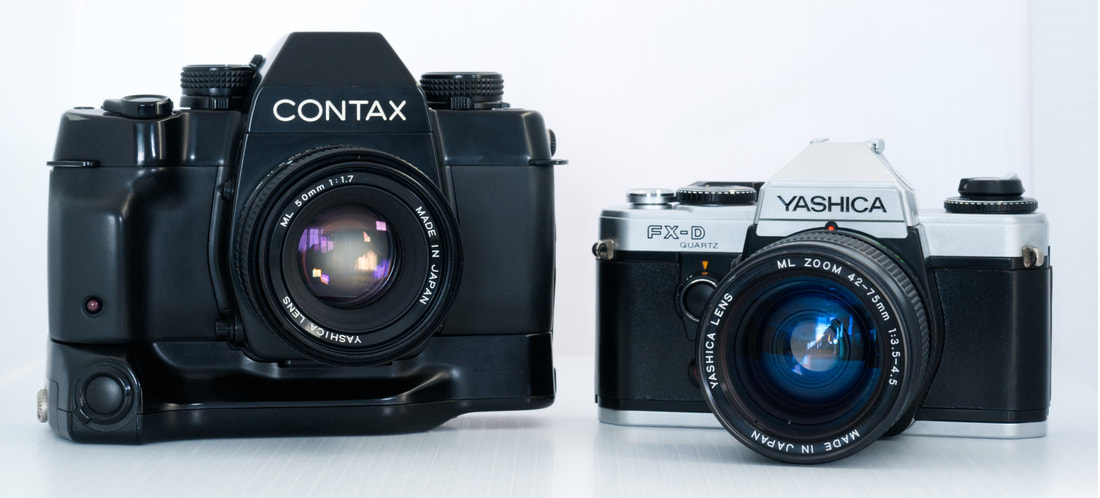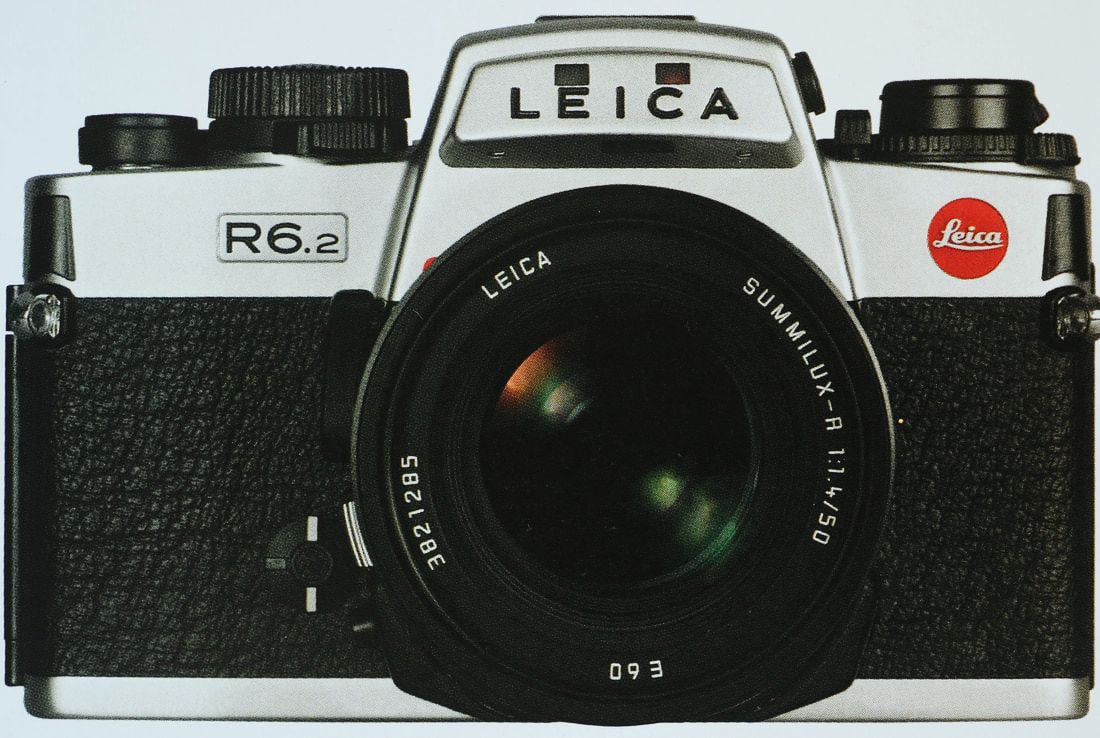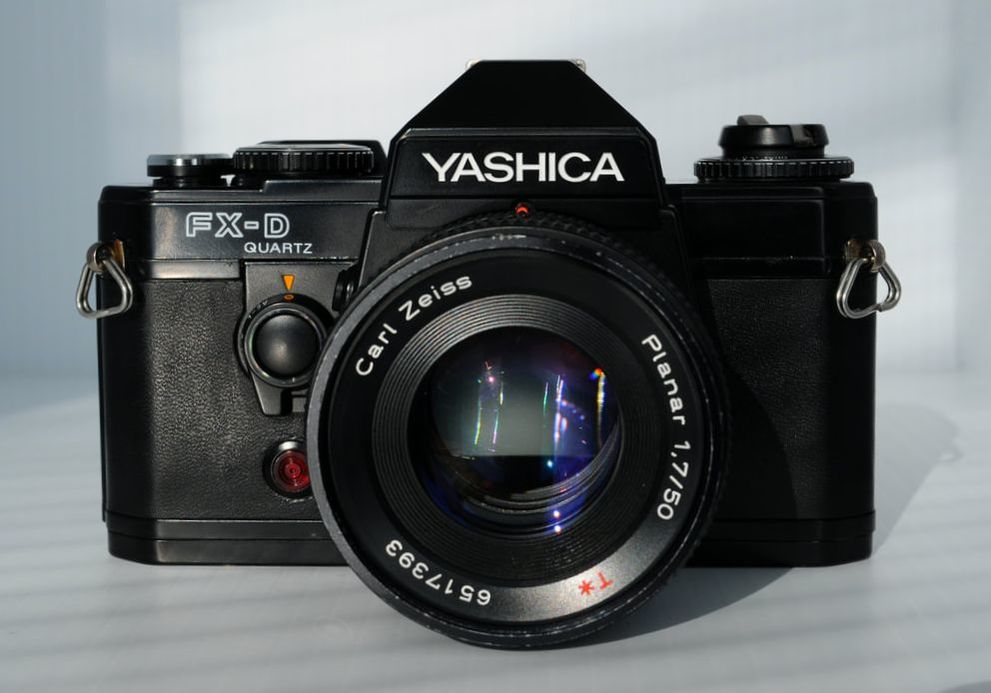In this same poetic sense, there are truly creative individuals who can find limitless nuances of light and color within a single blossom. These are true artists even if they've never held a paintbrush in their hand or drawn a single line. These are the souls endowed with the innate gift of being able to see with a Renoir's eyes. Whew!! You've got to hand it to the ad agency for CONTAX in the early-1990s; they came up with some doozies. Now, it's Advertising 101 to hype your product, but not even Leica dared to push it as far in their ads of the time ;-). Nothing like buttering up your potential customers by comparing them to an Impressionist master (eyeroll). By comparison, when they introduced the ST two years later, they were slightly more subdued, if only when referring to the potential users of this "extra" perfect camera:
4 Comments
Yes, it's been a long time in coming, but we will now resume our "Choosing a Vintage SLR System" series. Previous articles delved into the Big 5's (Canon, Minolta, Nikon, Olympus, and Pentax) manual focus (MF) 35mm SLR ecosystems, breaking them down into five main sections: 1) Lenses, 2) Bodies, 3) Flash, 4) Accessories, 5) Reliability & Servicing. We will now start digging into a series of smaller Japanese manufacturers that, while perhaps not as well-known nor heralded, were certainly influential in the industry and can offer interesting alternatives to the Big 5 in your search for an SLR system. We (re)start with CONTAX/Yashica, a collaboration between Zeiss and Yashica. As before, we will confine our consideration to the MF system, which is where C/Y made their greatest mark (their Auto Focus or AF system, unfortunately, never amounted to much, in spite of a promising R&D program in the early-'80s). By the time the 1990s rolled around, Auto Focus (AF) 35mm SLRs had become the de facto standard for amateur photogs and were well on their way to domination amongst professionals, too. Manual focus (MF) market share had fallen to less than 10% of total SLR production by 1989. As is common when such market shifts occur, manufacturers will often try to compensate for a loss of sales volume by trying to sell higher-margin products. And so it was in the early-'90s: you had dirt-cheap (often sub-contracted), beginner-targeted MF SLRs on one hand, and a retro-wave of premium manual exposure, mechanical-shuttered models at the other, with the previous mid-level MF models all but abandoned. Ever since the advent of practical auto exposure models, there was a small, but vocal, group of hardcore traditionalists who railed against the constant march of automation & polycarbonization of their beloved SLRs. This niche market may have been small, but to the manufacturers with either zero AF market presence (READ: CONTAX, Leica, Olympus), or a relatively strong base of MF users (READ: Nikon) it was one definitely worth pursuing. This is their story... Updated Mar. 8, 2024 So where does our fixation with Top Ten Lists come from, anyways? Letterman? The Ten Commandments? Well, if you can't beat 'em.....Here, for your casual perusal, is a chronological consideration of ten important Japanese SLRs that pushed the development of such cameras forward for over 30 years. This is not to say that these are the 10 "top" or "best" SLRs of all time (far be it for me to be the arbiter of such things ;-)), and some may be less familiar than others, but all of them had an undeniable effect on the industry or market as a whole. Let's dive in :-). In automotive circles, the "sleeper" has a long and roguish history. Take a plain-Jane car and throw some serious performance bits under the hood and prey upon the unsuspecting (bwahahaha). A frumpy four-door with a quiet (at least at idle) exhaust makes it even tastier :-). When it comes to old SLRs, there is no such post-purchase hopping-up per se, but there were enough models that followed the spirit of the sleeper as far as looks and features went to make things interesting. The bonus today is that you can snag one of these soporific snappers for a fair bit less than their more-celebrated contemporaries, while giving up very little (if any) outright performance. Now, if I happen to leave out your favorite flies-under-the-radar film-burner, don't get uptight. Feel free to mention my misses in the comments, and who knows, maybe we will have to do a sequel. So...in no particular order... Updated May 2, 2022 In the land of manual focus SLRs circa 1984, things were looking grim. That old implacable foe, "market saturation", had once again surfaced from the depths of the eastern Pacific to wreak havoc on the sales charts of the Japanese manufacturers. Over a decade had elapsed since its previous appearance in the early to mid-'70s. The proliferation of affordable autoexposure SLRs, from 1976 onwards, had not only blunted that attack, but had then led to the greatest sales extravaganza for 35mm SLRs, EVER. But now, the denizen of the deep was back with a vengeance and taking names. Internal motors for film advance, LCD displays, and angular '80s styling were doing nothing to stem the tide. Only another big-time innovation was going to give the SLR makers a chance. Their trump card? Updated Aug. 11, 2023 1975 saw the introduction of the CONTAX RTS, the first camera since 1961 (when the Contax IIa/IIIa rangefinders were discontinued) to bear that moniker and which was the firstfruits of the technological alliance between Zeiss (owners of the Contax name) and Yashica, the Japanese camera maker (who did the actual manufacturing). The RTS (which stood for Real Time System, to emphasize the supposedly superior responsiveness of the body) was aimed at professionals and serious enthusiasts with pocketbooks sufficiently large to take on the task of mounting pricey Carl Zeiss glass in front of it. The RTS was a success, but as Nikon had found out two decades earlier with the F, having a single model camera lineup that aimed towards the high-end of the SLR market tended to limit opportunities for sales (less cameras sold = less lenses & accessories sold ;-)). So, four years later, in a move that mirrored Nikon's introduction of the enthusiast-oriented Nikkorex F in 1962 (followed by the more-successful Nikkormat of 1965), CONTAX/Yashica introduced their CONTAX-badged contender in the very-competitive amateur market. But what does this have to do with the Yashica FX-D? Let's find out :-). Welcome to the final installment of our "Choosing Manual Focus Lenses" series. In this article, we will look at the larger picture of lens sets in general and also check out a few options for specialty optics, such as macros and shift lenses. |
C.J. OdenbachSuffers from a quarter-century and counting film and manual focus SLR addiction. Has recently expanded into 1980's AF point and shoots, and (gack!) '90s SLRs. He even mixes in some digital. Definitely a sick man. Categories
All
Archives
June 2024
|





 RSS Feed
RSS Feed